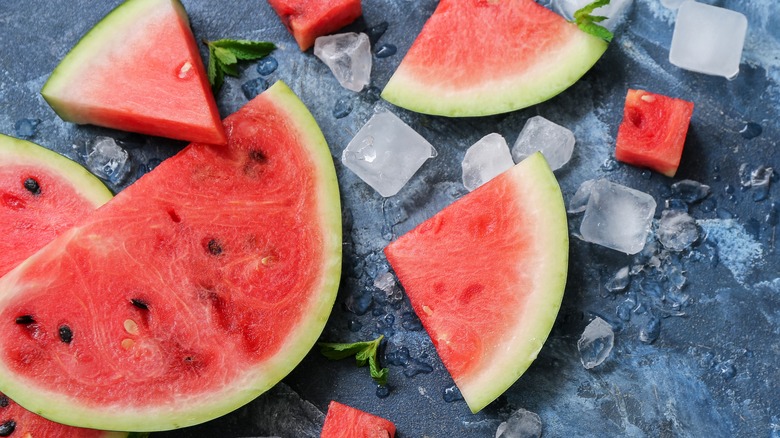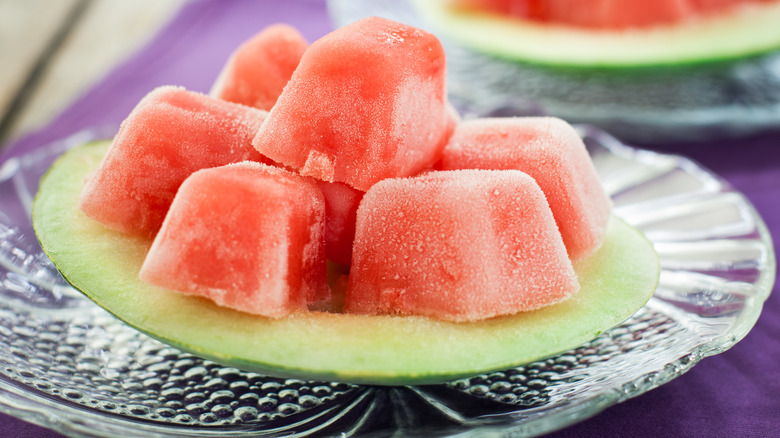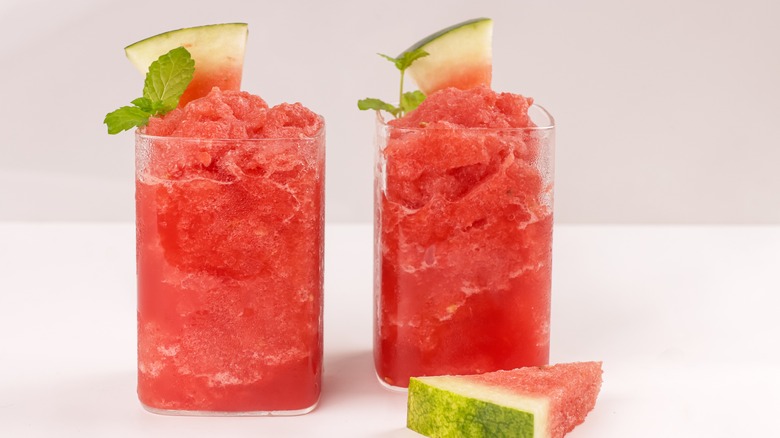Can You Really Freeze Watermelon Slices For Later?
A slice of sweet, juicy watermelon is a slice of summer itself. But unless you're having a party, this fruit can also be a bit of a commitment: The classic cultivar can grow up to 45 pounds, while the seedless varieties most popular today can reach 25 pounds. That's a lot of fruit to figure out what to do with. If you're looking at leftovers, start from the outside: You can pickle your watermelon rinds in vinegar, which both reduces food waste and gives you a delicious, slightly unusual accoutrement to stick on your next charcuterie tray.
But as everyone knows — in watermelons as in life — it's what's inside that really counts. While you can easily store cut watermelon slices in the refrigerator, the freezer offers a longer-term storage option that's just about as effortless. A few key tips: You want to freeze watermelon when it's at its ripest, to seal in all that summer flavor. You'll also want to remove the rind and, unless you're working with a seedless variety, any seeds as well, since they'll be harder to take out later.
As with other fruits, freezing changes the melon's structure, so it won't be possible to thaw it and enjoy as if it were fresh from the store. But with a little processing and a tiny bit of forethought, there are plenty of uses you'll be able to get out of the frozen fruit, from smoothies to popsicles to sorbets.
How to freeze a watermelon
When you're preparing your watermelon for its icy slumber, think ahead about what you might want to eventually do with it. You can swap cubes of frozen watermelon for plain ice in warm-weather drinks like lemonade, iced tea, or classic summer cocktails. For this, you'll want your pieces cubed up, or scooped into balls, that'll fit easily in a drinks glass; for a slightly more elaborate preparation, puree them with a little sweetener (like honey) and a splash of lemon or lime juice and freeze them in ice cube trays. On the other hand, if you're planning on eventually using your watermelon in some other pureed preparation — say, smoothies — the shape is less important, and you don't need to doctor it up with any added ingredients. Just cut it into manageable chunks.
Freezing itself is a simple process: Put your cubes, balls, or wedges on a single layer on a baking sheet lined with parchment paper, making sure that no pieces are touching, and stick them in the freezer until they're pretty much solid. Then and only then should you store the watermelon in a way that takes up less space, like gathered together in a plastic zipper bag. Freezing the pieces separately first means that later, you'll be able to reach into that bag and grab exactly as much as you need; otherwise, you'll find yourself with an icy, unforgiving mass. Watermelon will keep in the freezer for up to eight months.
What to do with frozen watermelon
The main thing to remember is that watermelon can't really be frozen and then fully thawed, which will render it — well — excessively watery, and possibly compromise the flavor and color. At about 92% water, these melons will break down while thawing into something closer to a puree than a cohesive chunk of fruit. So, look for ways that it can be incorporated into something cool and creamy — frozen margaritas, for instance. Ice cream, sorbets, sherbets, and granitas could also make for some fun options. Maybe even think about throwing a few chunks into your morning smoothie.
Or you can go dead simple: Easiest is to snack on watermelon straight from the freezer, like you'd snack on frozen grapes. Second easiest? Please make the acquaintance of the watermelon popsicle. All you need to do is slice the melon into wedges, insert a wooden, food-safe stick into the wide end of each one, and freeze on a sheet pan according to the directions about. Et voila: a one-ingredient frozen wonder to eat over the kitchen sink on the hottest day of the year.


